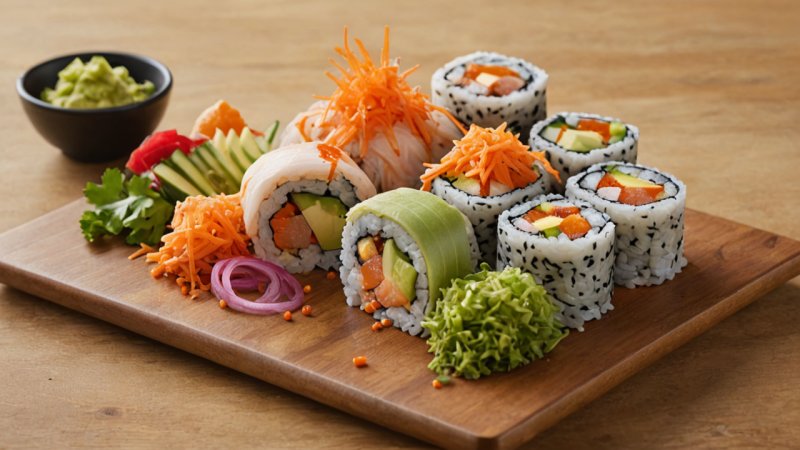In an increasingly interconnected world, culinary traditions have transcended borders, leading to the emergence of fusion cuisine. This innovative approach to cooking blends ingredients, techniques, and flavors from diverse cultures, often creating delightful and unexpected combinations. Whether it's a sushi burrito or a kimchi taco, fusion cuisine invites us to explore new tastes and culinary experiences that reflect the global tapestry of our modern society. This article delves into the fascinating world of fusion cuisine, examining its history, key characteristics, popular dishes, and the cultural significance behind this culinary trend.
The Origins of Fusion Cuisine
Fusion cuisine does not have a singular origin; rather, it is a reflection of migration, colonization, and the exchange of ideas among cultures throughout history. The concept has been present for centuries, with ancient civilizations often borrowing cooking methods and ingredients from neighboring regions.
However, the modern interpretation of fusion cuisine began to gain traction in the late 20th century, particularly in the United States. Influential chefs started experimenting with global flavors, leading to the creation of dishes that challenged traditional culinary boundaries. Names like Wolfgang Puck and Nobu Matsuhisa became synonymous with this innovative movement, showcasing how different culinary traditions could coexist harmoniously on a single plate.
Key Characteristics of Fusion Cuisine
Fusion cuisine is defined by its creative use of ingredients and techniques, often resulting in unexpected yet harmonious flavor combinations. Here are some key characteristics that define fusion cuisine:
- Ingredient Diversity: Fusion cuisine often incorporates ingredients from various culinary traditions, allowing chefs to experiment with textures, flavors, and aromas.
- Technique Blending: Chefs may combine cooking techniques from different cultures, such as grilling, steaming, or frying, to enhance the final dish.
- Presentation: The visual aspect of fusion dishes is equally important. Chefs often present their creations in a way that highlights the cultural influences behind each component.
- Innovation: Fusion cuisine encourages culinary experimentation. Chefs are not afraid to break the rules, leading to the creation of entirely new dishes that surprise and delight diners.
Popular Fusion Dishes from Around the World
As fusion cuisine has evolved, a myriad of dishes has emerged, each showcasing the unique blend of flavors and cultures. Here are some popular fusion dishes that illustrate the creativity and diversity of this culinary trend:
1. Sushi Burrito
The sushi burrito is a perfect example of fusion cuisine that has taken the food scene by storm. Combining the traditional elements of sushi, such as rice, fish, and vegetables, with the portability of a burrito, this dish allows for a customizable experience that appeals to a wide audience. Diners can choose their preferred fillings, sauces, and toppings, creating a personal culinary masterpiece.
2. Kimchi Tacos
Kimchi tacos marry the bold flavors of Korean cuisine with the beloved Mexican taco. This fusion dish typically features a tortilla filled with marinated meats, fresh vegetables, and, of course, spicy kimchi. The result is a delightful explosion of flavors that showcases the best of both culinary worlds.
3. Pad Thai Pizza
Combining the beloved Thai noodle dish with the classic Italian pizza, pad thai pizza is a creative twist that has captured the hearts of many. Toppings such as shrimp, peanuts, bean sprouts, and lime are layered onto a pizza crust, offering an unexpected yet satisfying culinary experience.
4. Curry Risotto
This dish fuses the creamy, rich texture of traditional Italian risotto with the aromatic spices of Indian curry. The result is a comforting and flavorful dish that showcases the best of both worlds, highlighting how different culinary traditions can complement each other.
The Cultural Significance of Fusion Cuisine
Beyond its deliciousness, fusion cuisine serves as a symbol of cultural exchange and globalization. It reflects the blending of different traditions and the ability of food to bring people together. As communities become more diverse, fusion cuisine allows for an appreciation of different culinary heritages, fostering understanding and respect among cultures.
Moreover, fusion cuisine often challenges preconceived notions of authenticity in food. While traditionalists may argue that certain dishes should remain unchanged, fusion cuisine encourages culinary creativity and the evolution of flavors. It invites chefs to draw inspiration from their own backgrounds while celebrating the influences of others.
Traveling for Fusion Cuisine
For food enthusiasts, traveling to experience fusion cuisine can be an exciting adventure. Many cities around the world have embraced this culinary trend, offering a plethora of restaurants and food trucks that serve unique fusion dishes. Here are some destinations known for their vibrant fusion cuisine scenes:
- Los Angeles, USA: With its diverse population, Los Angeles is a hotspot for fusion cuisine. From Korean BBQ tacos to Thai-inspired burgers, the city offers a wide range of culinary delights that reflect its multicultural influences.
- London, UK: London’s culinary scene is a melting pot of global flavors. Restaurants like Dishoom offer Indian-inspired dishes with a British twist, while others experiment with flavors from Africa, Asia, and the Caribbean.
- Toronto, Canada: Known for its multiculturalism, Toronto showcases fusion cuisine at its finest. Diners can find everything from sushi pizza to jerk chicken poutine, highlighting the city’s diverse culinary landscape.
- Melbourne, Australia: Melbourne is celebrated for its vibrant food scene, where chefs often blend Mediterranean, Asian, and local Australian flavors to create innovative dishes that tantalize the taste buds.
Tips for Exploring Fusion Cuisine
If you're eager to explore the world of fusion cuisine, here are some tips to enhance your culinary adventure:
- Be Open-Minded: When trying fusion dishes, approach them with an open mind. You may be surprised by how well different flavors can complement each other.
- Ask for Recommendations: Don’t hesitate to ask locals or restaurant staff for their favorite fusion dishes. They can guide you to hidden gems that may not be widely advertised.
- Experiment with Pairings: If you're feeling adventurous, try pairing fusion dishes with beverages from different cultures. For example, enjoy a spicy kimchi taco with a refreshing Mexican horchata.
- Document Your Journey: Keep a food journal to document your fusion cuisine experiences. Take notes on flavors, textures, and your overall impressions to reflect on later.
Conclusion
Fusion cuisine represents the evolution of culinary traditions in our globalized world. By blending flavors, techniques, and ingredients from various cultures, chefs create innovative dishes that challenge our palates and broaden our culinary horizons. As we travel and explore different cuisines, fusion food serves as a reminder of the beauty of diversity and the potential for creativity in the kitchen. Whether you're enjoying a sushi burrito in California or kimchi tacos in Seoul, fusion cuisine invites us to celebrate the rich tapestry of flavors that our world has to offer.






